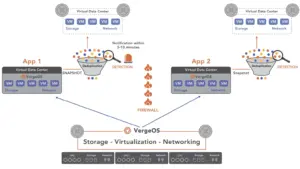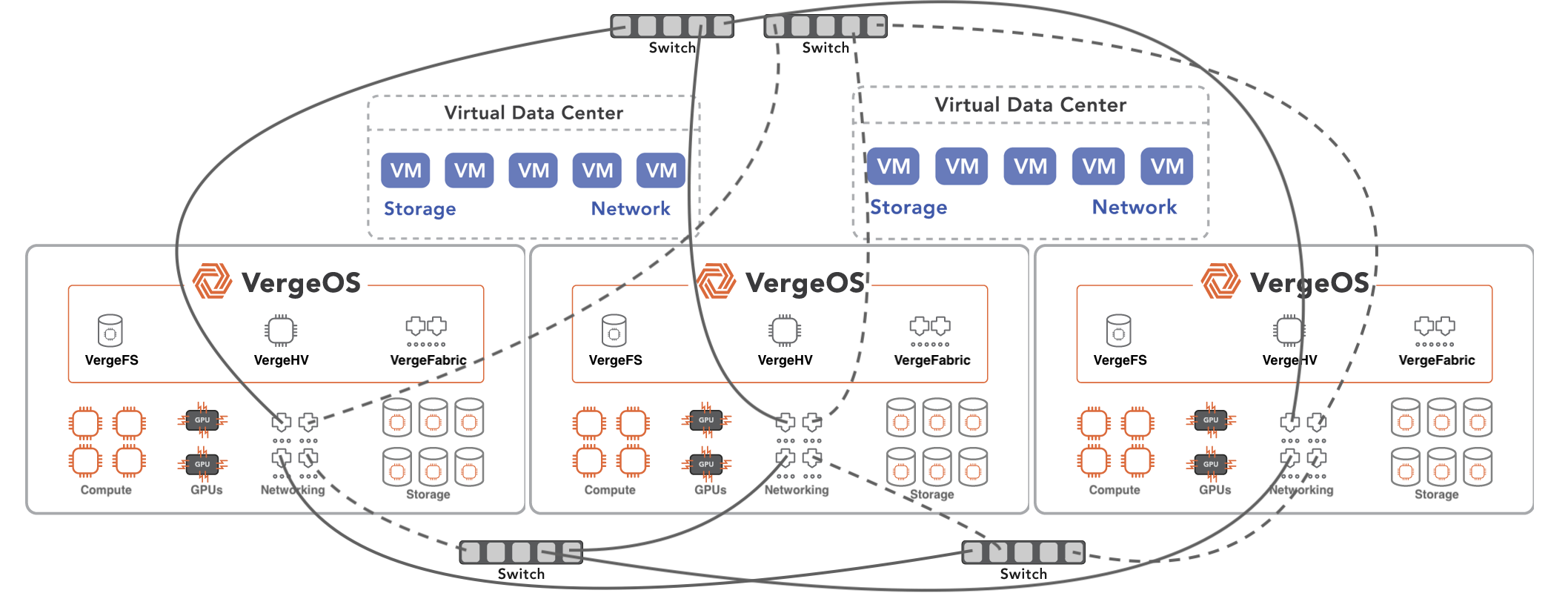For data centers, realizing the full value of scale requires a single infrastructure that can scale in multiple dimensions and address multiple use cases. Customers today can select a legacy, single-dimension, scale-out strategy like hyperconverged infrastructure (HCI). However, they then experience scale-out sprawl because they need a scale-out architecture for production applications, a scale-out architecture for unstructured data, and a scale-out architecture for data protection. These designs will never enable customers to benefit from the full value of scale.
As we discussed in our on-demand webinar, “How to Eliminate the Data Center Scale Problem,”, the solution is a single infrastructure, not multiple infrastructures. That infrastructure must scale in all three dimensions, not just “out.” It also must allow incremental adoption because most organizations won’t “clean sweep” their data centers.
The Full Value of Scaling Large Instead of Out
While hyperconverged infrastructure (HCI) vendors claim to scale out, most customers find that they, for technical or practical reasons, can only “scale medium.” Despite claiming to converge virtualization, networking, and storage, most HCI solutions are software-defined storage (SDS) running as a virtual machine (VM). They are stacking the three tiers (compute, storage, networking) instead of converging them.
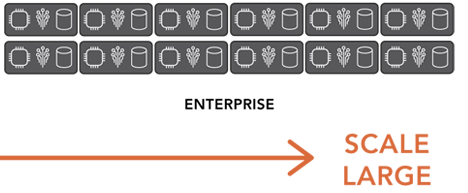
For virtualization, these products typically force you to pay separately for a third-party hypervisor like VMware ESXi, or bundle an open-source version, with little to no optimization. When it comes to networking, most HCI solutions provide little to no functionality and instead rely on the often limited capabilities of the hypervisor. The result of borrowing and bundling code creates a burden on the infrastructure, which worsens as IT adds additional nodes. IT professionals refer to this overhead as the virtualization tax. As a result, most HCI infrastructures only support one workload and don’t typically scale that architecture beyond six to eight nodes.
Ultraconverged Infrastructure (UCI), instead of stacking layers of code on top of each other within each node, rotates the stack into a single layer, creating a cohesive piece of data center operating software. VergeOS, for example, is a UCI solution architected so that virtualization, networking services, and storage services are all integrated, almost eliminating the virtualization tax. UCI’s efficiency can scale to hundreds of nodes without wasting resources so that even the largest enterprise can consolidate all their workloads onto a single infrastructure.
Scaling large helps organizations realize the full value of scale by enabling organizations to keep the same infrastructure no matter how many new workloads the organization needs to support. It simplifies IT operations and dramatically lowers IT cost.
The Full Value of Scale: Delivering The Edge
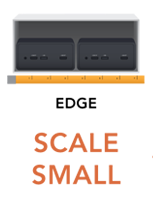
Only some organizations need massive scale, and even enterprises that do will have Edge locations and branch offices that need localized IT resources. Scaling small is a more significant challenge than scaling large. Mid-size data centers and branch offices often have a smaller IT team, sometimes a team of one. Edge locations are hard to get to and have an IT team of zero. In all cases, space is often limited, but high availability is often a mandate.
The “scale medium” HCI solutions often require three nodes. Overcoming the overhead caused by the virtualization tax requires that those nodes have powerful processors and high-performance storage, even though compute and storage performance requirements are modest. Mid-range processors and a mixture of flash and hard disk drives will meet the requirements of many of these environments. The legacy HCI node-similarity requirement forces customers into using high-end processors and flash-only configurations. The result is that HCI becomes very expensive for Server Rooms and Edge Computing.
UCI can scale small. IT can create a cluster with only one or two small nodes for high availability (H/A). The efficiency of VergeOS enables Edge Computing, especially when IT planners couple it with two mini-servers like Intel’s Next Unit of Computing (NUC). In the space of a shoebox, you can deliver Edge Computing power and consume less than 12 watts, and delivers more than enough performance for multiple workloads.

For the Server Room use case, VergeOS can use two or three low-end to midrange servers, enabling you to consolidate all your workloads onto one infrastructure, eliminating dozens of extraneous software packages and processes.
Scaling small helps organizations realize the full value of scale by reducing the cost and complexity of managing Edge Compute. It also enables mid-sized data centers to keep pace with larger organizations even though they have much smaller IT teams. Whether you have hundreds of Edge data collection points or are an IT team of one, VergeOS can solve your virtualization, storage, networking, and data protection challenges.
The Value of Scaling Vertical
Vertically scaling your infrastructure is one of the essential requirements to realizing the full value of scale, but it is often lacking from HCI solutions. Most HCI solutions require that each additional node added to the cluster has similar processing power, IOPS performance, and storage capacity as the existing nodes. While it is true that some HCI vendors have a concept of a capacity node, that node often comes with ramifications. One vendor, for example, suggests turning off deduplication if you add a set of capacity nodes, which means you will need even more of them.
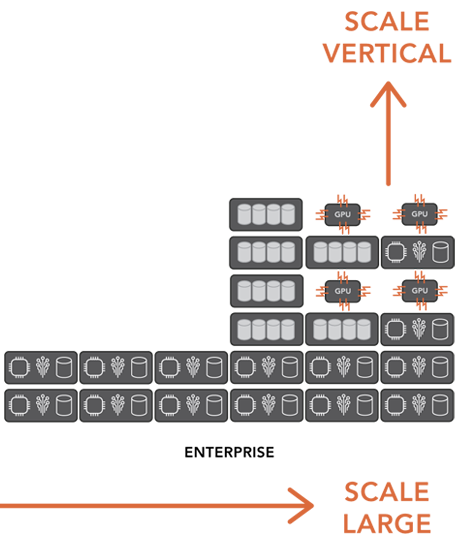
Node similarity leads IT professionals only to use HCI for one specific workload. UCI is different in that it can support multiple nodes within the data center operating system (DCOS). A single environment can contain nodes with different processing capabilities from different manufacturers. It can even mix in nodes with Graphics Processing Units (GPU). Nodes can be storage performance focused with NVMe flash, and other nodes can be capacity focused with high-density but low-cost hard disk drives.
The mixture of nodes does not increase complexity. IT can organize nodes by their capabilities into specific clusters. The clusters are then seen through our Global Resource Pool. Using our Virtual Data Center (VDC) technology, an IT administrator can dedicate certain cluster types to particular VDCs, or the capabilities of a cluster can be made universally available to all VDCs. This is all easily done through the VergeOS dashboard.
A VDCs can be created for each workload type or set of workloads with a common resource requirement. For example, suppose you have a mission-critical performance-demanding application. In that case, the infrastructure must deliver consistent, high-performance; you can dedicate the resources from a specific high-performance storage cluster (NVMe Flash) to that VDC. The VDC can even be nested so that you can have a production instance, a development instance, and a QA instance of that application. Our deduplication and snapshots make this nesting practical because they eliminate redundant data.
The vertical dimension also helps organizations realize the full value of scale by doing something they may have thought impossible, complete workload consolidation. When looking at workload or even storage consolidation, IT planners worry about workload integrity, ensuring the workload will get the performance or capacity it needs when needed. With UCI, you can mix nodes and add specific resources for specific workloads ensuring consistent performance and happy users.
The Full Value of Scale: Deep
Scaling Deep is another dimension data centers need to extract the full value of scale. It ensures existing resources are almost entirely utilized before adding more nodes. While scaling large is vital, you only want to scale as large as you must and no further.
Scaling deep requires ensuring the vendor optimizes the software for the hardware it is managing. Delivering optimization while maintaining hardware abstraction requires very talented developers. It also needs to provide features like deduplication to ensure capacity efficiency. These optimizations require that the UCI vendor own the code and can get into the low levels of the software to make those optimizations. Vendors who borrow an off-the-shelf or open-source hypervisor don’t own the code to make the improvements if they want.
VergeIO’s developers have taken talent and ownership to an extreme. VergeIO not only owns the code and has very talented developers, and we created a specific programming language and development environment to get around the limitations of traditional programming stacks. It enables us to remain agile, even 12 years into the product’s maturity.
Scaling deeps helps organizations realize the full value of scale so they can slow the growth of IT spending. Most HCI solutions are less than 10% utilized, but these vendors continue to force their customers to add additional nodes to cover the virtualization tax.
How to Get from Many to One
Clearly, scale-out is not enough; data centers need the multi-dimensional scale that UCI provides. The vision of UCI is compelling, one data center operating system that replaces dozens of others while driving down the cost and complexity of IT.
Starting is simple, identify one workload whose infrastructure needs refreshing. Maybe it’s time to replace a SAN or NAS, or you are considering HCI and are looking for a more cost-effective and scalable alternative. Maybe you are a member of a small IT team with a small data center and are looking to simplify everything. Or You have an Edge Strategy that has stalled or never got off the ground.
You can also get an in-depth education into the VergeOS architecture with our Digital Learning Guide, “Understanding the VergeOS Architecture.“
All of these are great places to start with VergeIO. Want to learn how UCI can map into your infrastructure plans? Schedule a meeting with one of our technical specialists today.


